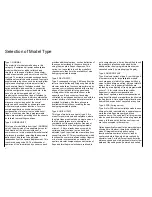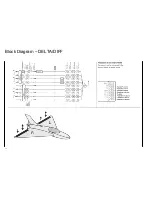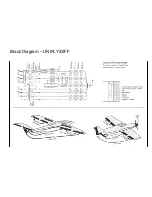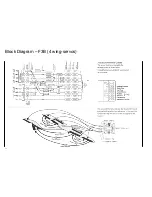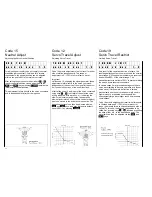
Mode of Operation Analogue Adjustment
of Values
7
later on. For other applications seven freely
programmable mixers are available.
Type 7: F3B (4 wing servos)
Type 7 corresponds to type 6, with the exc eption
that in the case of type 7 the flaps are actuated
by a separate servo each, thus providing
additional mix options (ailerons -flaps) which are
also realised by a special mixer. Here, too,
seven freely programmable mixers are available.
The universal Profi program can also be used for
models have two wing mounted servos. In this
case the functions not required are left
unoccupied in the receiver.
Type 8: HELI
Type 8 is a universal helicopter program for
practically all helicopters, unless they are not t o
be operated exclusively with an RPM regulator
which can not be turned off or overridden by the
throttle channel. Here one finds all currently
imaginable options for helicopters of all types
and sizes, both for normal operation and for
demanding competiti on work.
Type 9: HELI (with speed control)
Type 9 is suitable for model helicopters which
are exclusively operated with a speed control
operated via an auxiliary channel. In this case
the compensating functions acting on engine
control are missing. Other c ontrol functions
effect the auxiliary channel, which in turn
correspondingly controls the regulator. If a speed
control is used, which can be turned off or
overridden by normal throttle control, type 8
should be used.
The mode of operation permits skimmi ng
through the program of a model by pressing key
LIST-DM
, then pressing
INC
to go forwards
and
DEC
to go backwards. Aster the desired
code number has been found, the program in
question can be selected using the
ENTER
key.
The value can then be se t using the
INC
and
DEC
keys as well as
CLEAR
and
1
…
9
,
respectively.
The survey of contents is vacated by pressing
the
CLEAR
key while a new code number and
title of the code appears in the lower line of the
display.
The functions of the
INC
and
DEC
keys can
be taken over by a proportional rotary module
(order number 4111) wire to plug station AUX or
a proportional module (order number 4152).
Calling the function is performed as before, but
at that station where adjustments are to be
made, normally by the
INC
and
DEC
keys, the
rotary control is activated by key
9
. Adjustments
are then made performed using the rotary
control. In the case where the adjustment range
of the rotary control should prove inadequate to
obtain the desired val ue, the rotary control has to
be turned off on reaching the end position, via
the
DEC
key, and then reset to suit, turned on
again via key
9
. This step can be repeated as
often as required.
This analogue adjustment option can, in
principal, be used at all stations where inputs are
possible via
INC
and
DEC
keys, including for
example for skimming the list of codes.
If, on imputing the name of the model, the
selection of letter is performed using analogue
setting, numbers, lowercase letters and specia l
symbols will be available in addition to the
normally available capital letters.
After the PROFITRIM -module has been
installed, the right upper control will take over the
functions described above. Its normal function
will be interrupted automatically at the same
time.
Summary of Contents for mc-18
Page 1: ...1...
Page 10: ...Block Diagram NORMAL 10...
Page 11: ...Block Diagram NORMAL DIFF 11...
Page 12: ...Block Diagram DELTA DIFF 12...
Page 13: ...Block Diagram UNIFLY DIFF 13...
Page 14: ...Block Diagram Quadro Flap 14...
Page 15: ...Block Diagram F3B 3 wing servos 15...






